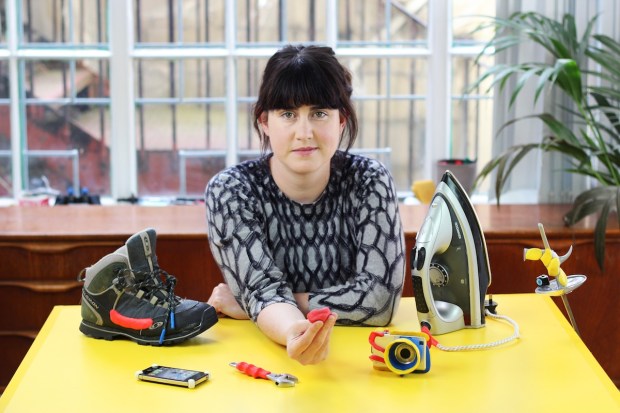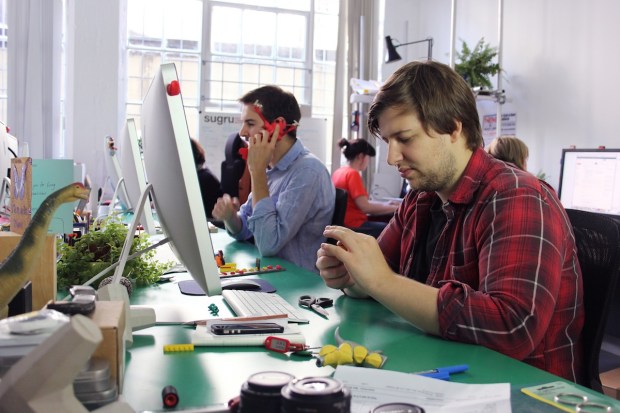

Sugru, the self-setting rubber that can be used to hack, mod or fix almost anything, can be found in many a maker’s toolbox. Jane ni Dhulchaointigh, who invented it, is well-known to makers in the UK and further afield. The story she tells of Sugru’s development over the last 10 years is an inspiring one of struggle and perseverance. So when she offered me a tour of their factory in Hackney, I jumped at the chance to find out more about how it’s made, and where it came from.
Jane grew up in an environment surrounded by fixable things; an Irish family farm where if something wasn’t quite right, they just modified it until it was.
“Exactly,” she picks up, “It’s an old farm. Our family has lived there for 350 years. It’s changed so much over time. Our house, for example, started as a two-room house, one for animals, one for people. It’s like a classic Irish farmhouse evolution. It grew to the side a bit, and then animals were put outside, and then it grew another little bit to the side. And then I think they started having a courtyard. And then at some stage they learned how to build stairs, and it went up,” she says gesturing towards a second floor. “Our house probably has nearly 15 extensions. It’s all totally higgeldy piggeldy.
“With a farm, you build what you need at that time. For example, we do lambing every year. All of our pens are built with pallets. You always keep pallets, and you keep tires, you keep all these modular things that allow you to build what you need for the next season.”
The bodger’s spirit stayed her when she moved to London to study design at the Royal College of Art, and informed her early experiments with silicon caulk and wood dust, the ingredients of the first prototype versions of what was to become Sugru.
Fast forward to 2013, and Sugru has grown to a team of 40 people, most of them based in an anonymous-looking light-industrial building in Hackney. It might seem like a long way from the Irish farmhouse, but in many ways, this building is a fitting home for a product that’s all about improving the stuff around you — something that’s evident from the moment you press the front door buzzer.

The building is an expansive brick unit in an area filled with makers, artists and young tech startups. I ask Jane about its history:
“This was a button factory in Victorian times. It was a painters studio before we moved in. It’s probably had so many lives over the years,” she says. She draws a comparison with MIT’s famous Building 20, celebrated by Stewart Brand in his book and TV series, How Buildings Learn. Building 20 was cheap, ugly, and endlessly re-configurable, “the only building on campus you can cut with a saw,” Brand notes.
While I see no evidence of holes cut in the walls in this old button factory, it’s clear that it’s the perfect environment in which to develop a product that encourages people to hack, bodge, improve and customise.
“That’s why I invented Sugru,” says Jane, “to bring a bit of that spirit into the everyday urban culture. So we don’t see everything as finished. What if we saw everything as unfinished? What if even the person who sent it out from the factory thought it was unfinished?”
Jane is not the first person I’ve spoken to who’s interested in the idea of unfinished products. Alice Taylor, founder of Makielab, who make personalised, 3D-printed action figures, also told me how the unfinished nature of their figures encourages creative play and story-telling. And as with the Makie dolls, stories are at the heart of Sugru’s success.
Sugru, as a company, are an instructive example of how to build an audience of fans and customers. Any maker who’s interested in sharing their projects more widely, or building a community of collaborators; selling kits, or developing a commercial product, could do worse than copy some of the approaches Sugru have used to grow their business.
Sugru super-users — fans of the product — share their hacks, inventions and mods with Sugru, who in turn adapt that content and share it back with the wider community.

“We’ve grown entirely through word of mouth,” Jane says. “Generally from people sharing their photographs with us and then we’ll share it back. It’s usually about us trying to understand what the application is, and then putting that in a story format, that will work well on the website, and is easy for people to read and understand.
“Then we share it with other communities that are going to be interested. We have a whole network now, that we’ve built up over the years, like Instructables and various blogs, who love to inspire their readers about leading a more creative life or whatever, and giving them inspiration all the time. The very best ideas, we elevate into — I guess — a more sophisticated form of content, like videos or how-to tutorials.”
Tim, one of Sugru’s video editors and designers is working on one such piece as we talk. He’s editing footage of a canoeist training for a race.
“Last summer,” Jane explains, “one of our users, Joanne — she didn’t have any fingers on her left hand, but she wanted to compete in this ultra-marathon race, and she modified her canoe paddle. This year, she wanted to do the race again, and she asked if we’d be interested in sponsoring us. That enabled her to buy some lighter paddles.”
“This is an example of a really nice story: with the Sugru, Joanne’s been able to do something in her life, that she wouldn’t otherwise have been able to do at all. And she says it’s one of the best things she’s done in her life. For us, that’s a really cool story, and I think it’s inspiring for the rest of our community.”
While the Sugru team have invested heavily in telling Joanne’s story, some stories seem to tell themselves. When a team of 3D printing engineers tested their custom extruder with Sugru and made a demo video, it was an instant hit with both 3D printing and Sugru fans.
Local manufacturing
While bloggers and editors are engaging with fans, a few feet away, behind a huge glass wall, sit Sugru’s materials scientists, busy developing new formulations of the core material technology, called Formerol, that Sugru is made from.
“We have four people working full-time on optimising our material, and developing it for the future: improving the shelf life, and developing our chemistry so that it will be kid-safe, so we can sell it as a toy. And looking to the future, we’re sponsoring some PhDs at our local university, Queen Mary’s, which is one of the best material science centers in the country. That’s also looking at the chemistry for kids, but also for medical use as well.”
And at the other end of the office sits the manufacturing and packing operation. Everything, bar fulfilment to end-customers, is done in this one building.
Jane says, “we’re making all the Sugru that we ship out to the world here, and we intend to continue that until it’s economically viable to set up another micro factory somewhere else. It’s about making a micro-factory that we can then photocopy somewhere else.”
So why not move production to China?
“It doesn’t make economic sense right now,” says Jane, “and for us, the making part of our company is actually really important. At stages people have suggested we outsource — and we’ve tried various times, but actually having the making and manufacturing part in the business makes total sense in terms of our philosophy. We’re trying to encourage everyone to know more about making, and we’re trying to champion the value of making in society as well. In our local area, we’re very proud to be a manufacturer, and to make sure that the ecosystem of our area isn’t just people working on computers all day. Actually they’re people who are making stuff. And people really enjoy that. They say, ‘Wow this is actually made here in Hackney? Amazing!’
“That whole thing about making in China — for us at least, it’s just an illusion that it would be cheaper. If you can make stuff locally, and invest in some automation, and efficient manufacturing processes, you’re totally fine.
“We used to outsource our packing, and we learned that we spent so much time managing it, that it was easier just to do it. And also, quality control is so difficult to monitor from afar. As soon as we brought it in-house, our quality went right up. And flexibility as well – we can make changes very easily, we don’t have to give any notice; if we want something, we can make it that day.”
The factory itself is a simple affair, with about 10 people operating machines to mix and pack the Sugru. The raw ingredients are mixed in a temperature and humidity-controlled environment, in batches of 100kg at a time.


Many of the machines are on homemade jigs, modified, extended and enhanced over time, much like the farm buildings of Jane’s childhood home. Huge sausage-shaped bags of Sugru are mounted into one of these jigs, and extruded and cut into 5g pieces. Then they’re put into individual heat-sealed packs. The packs themselves are a clever appropriate of technology from much larger-scale industries:
“All of our ingredients are from other industries. We benefit from the fact that say, some of our ingredients will be used in huge volumes in shampoo and hair conditioner. Or our packaging material (a metallised plastic film) has been commoditized by the coffee industry. All these things are super high-tech materials, but we can afford them, because other industries use them lots. We use them in quite small amounts, but getting bigger all the time!” says Jane.

Sugru is a growing brand, now available in DIY retailers like B&Q in the UK, and making inroads into mainland Europe and the USA. It’s also moving beyond its maker roots. One of the projects Jane is most excited about is a new product incorporating Sugru as an essential part of the design, rather than a hack, or an add-on.
It’s a foil handle for fencers, jointly developed with Leon Paul, a British fencing equipment manufacturer. Rather than use the handle as-is — a finished product out-of-the-box — fencers can use the Sugru to make a custom grip around a metal core that perfectly fits their hand and personal style.
In the future, perhaps more of the things we buy will be unfinished, ready for us to make our own.
Browse the gallery of Sugru hacks or find a source near you. You also stand a good chance of meeting the Sugru team at your local Maker Faire.
Andrew Sleigh is a maker and fixer from Brighton, UK. He co-founded Brighton Mini Maker Faire, and Hardware Startup, a new community for pro makers in the UK. He sticks to most clean, dry surfaces.
ADVERTISEMENT







